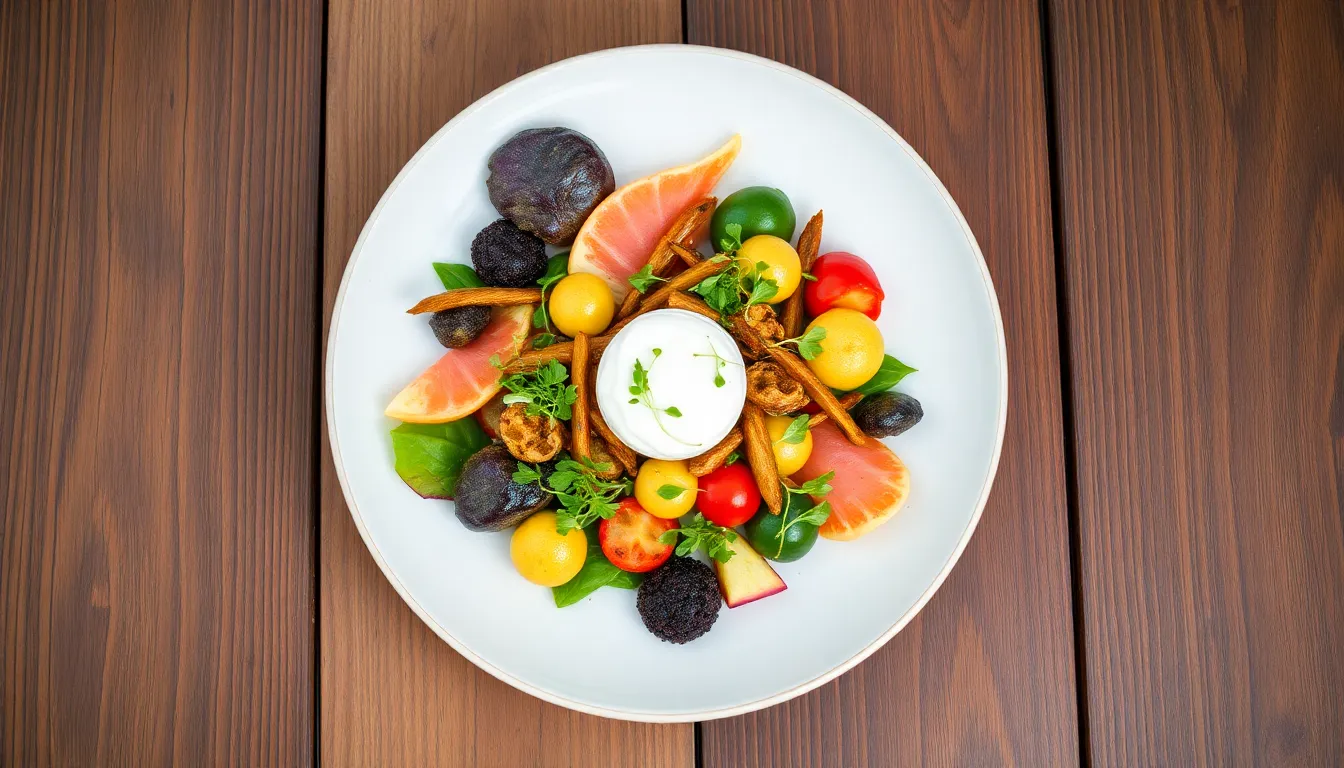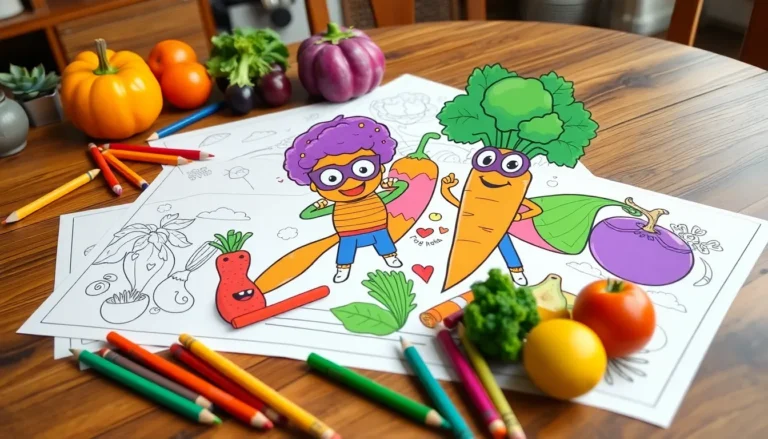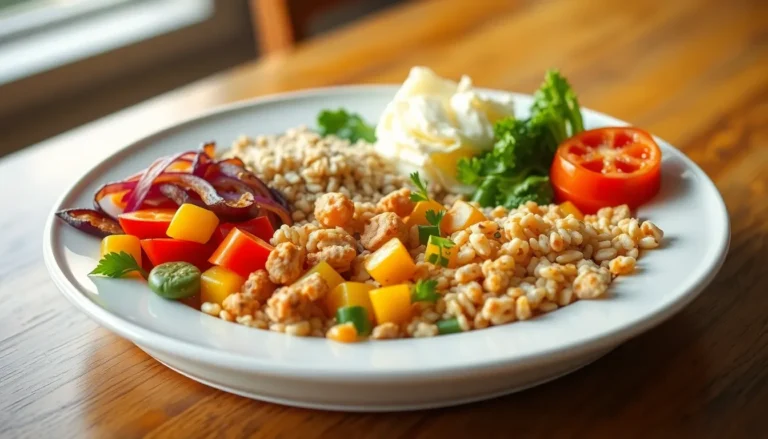Imagine sitting down to a meal that looks so good it could make a food critic weep. The perfect plate isn’t just about taste; it’s a visual feast that tantalizes the senses and sparks joy. From vibrant colors to artful arrangements, it’s like a masterpiece that demands to be devoured.
Table of Contents
ToggleUnderstanding The Perfect Plate
The perfect plate combines taste, color, and artistic presentation. It transforms a meal into an enjoyable visual experience.
Definition Of The Perfect Plate
The perfect plate represents the harmony of flavors and aesthetics. This concept embodies a balance between visual appeal and gastronomic satisfaction. Culinary experts define it as an arrangement of food that captivates and engages the senses. A perfect plate invites people to appreciate the meal before even taking the first bite. It emphasizes that both looks and taste play crucial roles in dining.
Key Components
Various elements contribute to achieving the perfect plate. Color stands out, as vibrant hues enhance visual interest. Texture adds depth, with contrasting elements complementing one another. Arrangement matters; strategic placement of food creates an artful display. Taste remains essential, ensuring the flavors harmonize and elevate the overall experience. Presentation tools, such as garnishes and dishware, further enhance the visual appeal, completing the perfect plate.
Elements Of The Perfect Plate

The perfect plate encompasses multiple components that contribute to a visually appealing and satisfying meal. Key aspects include color, texture, contrast, and arrangement.
Color And Presentation
Vibrant colors play a crucial role in attracting attention on a plate. Colors enhance visual appeal, making the meal more inviting and appetizing. Chefs often utilize a mix of hues to create a harmonious palette. When paired thoughtfully, ingredients like red peppers, green herbs, and yellow squash result in a stunning dish. Displaying food in sections or layers adds depth to the presentation. Furthermore, garnishes, such as microgreens or edible flowers, intensify the overall look. Attention to color not only captivates the eyes but also entices the palate.
Texture And Contrast
Texture adds an extra layer of interest to each bite. A successful plate features a variety of textures, balancing creamy, crunchy, and chewy elements. Textural contrast keeps meals exciting and stimulating. For instance, pairing crispy fried elements with soft, rich components creates a delightful contrast. Utilizing ingredients with different mouthfeels enhances the dining experience. In addition to texture, visual contrast in arrangement keeps plates dynamic and engaging. Layering foods with distinct textures ensures that each forkful delivers a unique experience, making the perfect plate unforgettable.
Cultural Influences On The Perfect Plate
Cultural influences shape the concept of the perfect plate, contributing to its visual appeal and flavor dynamics.
Regional Variations
Cuisine varies significantly across regions, with each culture defining its notion of a perfect plate. For instance, Mediterranean dishes often feature bright colors from fresh vegetables and olive oil, creating a vibrant tableau. In contrast, Asian cuisines emphasize balance through a mix of textures and flavors, presenting meals with meticulous attention to harmony and color. Furthermore, Latin American plates might showcase bold colors, utilizing spices and herbs to craft visually stimulating presentations. Every region offers unique ingredients and traditions, enriching the culinary landscape and enhancing the perfection of each dish.
Tradition And Modernity
The perfect plate balances tradition and modernity, blending age-old techniques with contemporary flair. Traditional plating methods often reflect cultural heritage, showcasing time-honored ingredients and cooking styles. Modern plating, however, embraces artistic freedom, focusing on minimalism or deconstruction to redefine classic dishes. Chefs often create innovative presentations that marry nostalgia with experimentation, appealing to both the diner’s senses and sensibilities. These influences embody the evolving culinary narrative, where heritage meets creativity in a captivating visual narrative.
Tips For Creating The Perfect Plate
Creating the perfect plate involves careful consideration of various elements. Attention to detail elevates the culinary experience.
Balancing Flavors
Balancing flavors is crucial for a well-rounded dish. Sweetness, acidity, saltiness, and bitterness each play vital roles in flavor profiles. Culinary experts suggest using complementary ingredients to enhance the fusion of flavors. For instance, pairing tart citrus with creamy avocado provides a delightful contrast. Incorporating herbs and spices brings depth, allowing distinct flavors to shine through. Tasting throughout preparation helps identify necessary adjustments to achieve the perfect balance. Achieving harmony among all flavor elements transforms a simple meal into a gourmet experience.
Portion Control
Portion control shapes both presentation and satisfaction. Heaping servings overwhelm the plate and diminish visual appeal. An ideal serving size showcases balance without masking the dish’s components. Using smaller plates encourages diners to appreciate each element rather than binge. Allocating specific portions for each food type maintains visual symmetry. Consider family-style plating for sharing while ensuring enough variety. Portion control contributes significantly to overall enjoyment, promoting a healthier relationship with food. Ensuring each bite represents the dish’s essence enhances the dining experience.
Creating the perfect plate is an art that goes beyond mere sustenance. It’s about crafting a sensory experience that engages both the eyes and the palate. By focusing on vibrant colors, contrasting textures, and thoughtful arrangement, anyone can elevate their meals into visually stunning masterpieces.
Cultural influences further enrich this culinary journey, allowing for a delightful exploration of global flavors and presentations. The balance between tradition and modernity in plating not only honors heritage but also invites innovation.
With practical tips on flavor balance and portion control, anyone can master the essentials of presentation. Ultimately, the perfect plate invites appreciation and joy, turning every meal into a memorable occasion.





